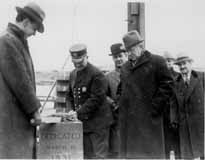 Station #19—known locally as the Northmoor Engine House– was the only Columbus fire station built during the Great Depression. It was built in between 1930 and 1931 for $39,887. Architecturally, the colonial revival building was intended to blend into the neighborhood—and it did so quite well. The building was dedicated on March 10, 1931 (shown). The station motto is “The Pride on High” and a lion is the mascot logo.
Station #19—known locally as the Northmoor Engine House– was the only Columbus fire station built during the Great Depression. It was built in between 1930 and 1931 for $39,887. Architecturally, the colonial revival building was intended to blend into the neighborhood—and it did so quite well. The building was dedicated on March 10, 1931 (shown). The station motto is “The Pride on High” and a lion is the mascot logo.
The engine house soon became too small to accommodate larger fire apparatus and engines had to be special ordered short and low to fit into the station’s small bays. At some point in time, the original bifold doors were replaced by overhead doors; a local resident stored the bifold doors and returned them for the latest, 2003, expansion. (Photo courtesy of Central Ohio Fire Museum)
Anyone out there recall the wonderful old log chairs that used to sit outside of the Northmoor fire station? Lore has it that they were made by prisoners at the old Ohio Penitentiary. Nowadays the few log chairs that remain in Clintonville are stored in the basement of the Northmoor station.
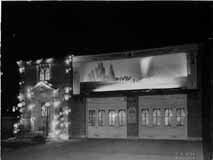 In the 1950s, The Columbus Dispatch ran an annual holiday decorating contest. The Northmoor fire house won several years in a row. (Photo courtesy of Central Ohio Fire Museum)
In the 1950s, The Columbus Dispatch ran an annual holiday decorating contest. The Northmoor fire house won several years in a row. (Photo courtesy of Central Ohio Fire Museum)
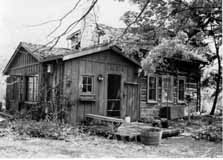 This diminutive log structure was built in Meigs County in 1840 and brought to Clintonville in 1937 by Grace McGrath, great-granddaughter of the original owner. The house was put next to McGrath’s home. McGrath was an art teacher at Central High School and she used it as an art studio. Subsequent owners have expanded the house with bathrooms, an updated kitchen and bedroom, and porch. (Photo by Inga Smith, photo displayed courtesy of the homeowner)
This diminutive log structure was built in Meigs County in 1840 and brought to Clintonville in 1937 by Grace McGrath, great-granddaughter of the original owner. The house was put next to McGrath’s home. McGrath was an art teacher at Central High School and she used it as an art studio. Subsequent owners have expanded the house with bathrooms, an updated kitchen and bedroom, and porch. (Photo by Inga Smith, photo displayed courtesy of the homeowner)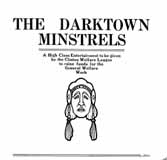 In the early part of the twentieth century, many Clintonville organizations and churches held minstrel shows, as fundraisers and for entertainment. I chose not to sanitize minstrel shows from my book, because they were an authentic part of Clintonville’s history, albeit the part we are all glad we’ve done away with. I regret any offense or hurt caused by these pictures.
In the early part of the twentieth century, many Clintonville organizations and churches held minstrel shows, as fundraisers and for entertainment. I chose not to sanitize minstrel shows from my book, because they were an authentic part of Clintonville’s history, albeit the part we are all glad we’ve done away with. I regret any offense or hurt caused by these pictures. 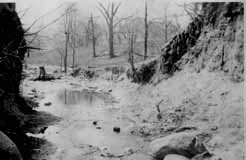 Old maps show at least 3 “Indian springs” within Clintonville. Overbrook Ravine, one of the Indian springs, was untamed and picturesque. Lore has it that Indians harvested cranberries along the brook. (Photo courtesy of Galen Gonser)
Old maps show at least 3 “Indian springs” within Clintonville. Overbrook Ravine, one of the Indian springs, was untamed and picturesque. Lore has it that Indians harvested cranberries along the brook. (Photo courtesy of Galen Gonser)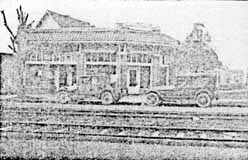 Joe Gratziano owned this market on the corner of North Broadway and High Street. It was a one-story brick building. Until quite recently, this building was still there but covered up. Note the house to the south of Gratziano’s, which exists today. Clinton Theatre had not yet been built.
Joe Gratziano owned this market on the corner of North Broadway and High Street. It was a one-story brick building. Until quite recently, this building was still there but covered up. Note the house to the south of Gratziano’s, which exists today. Clinton Theatre had not yet been built. 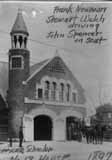
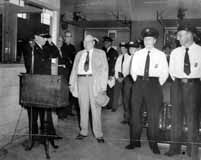
 Station #19—known locally as the Northmoor Engine House– was the only Columbus fire station built during the Great Depression. It was built in between 1930 and 1931 for $39,887. Architecturally, the colonial revival building was intended to blend into the neighborhood—and it did so quite well. The building was dedicated on March 10, 1931 (shown). The station motto is “The Pride on High” and a lion is the mascot logo.
Station #19—known locally as the Northmoor Engine House– was the only Columbus fire station built during the Great Depression. It was built in between 1930 and 1931 for $39,887. Architecturally, the colonial revival building was intended to blend into the neighborhood—and it did so quite well. The building was dedicated on March 10, 1931 (shown). The station motto is “The Pride on High” and a lion is the mascot logo. In the 1950s, The Columbus Dispatch ran an annual holiday decorating contest. The Northmoor fire house won several years in a row. (Photo courtesy of Central Ohio Fire Museum)
In the 1950s, The Columbus Dispatch ran an annual holiday decorating contest. The Northmoor fire house won several years in a row. (Photo courtesy of Central Ohio Fire Museum)